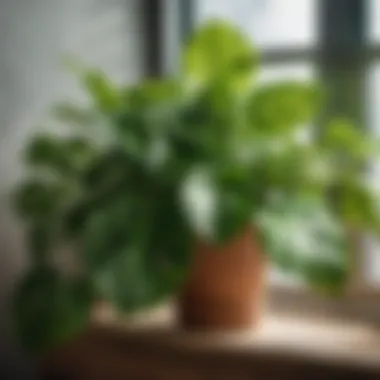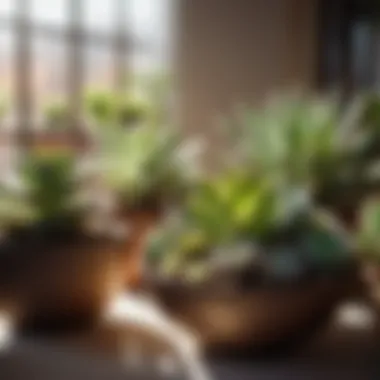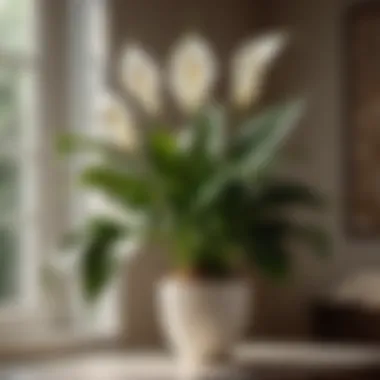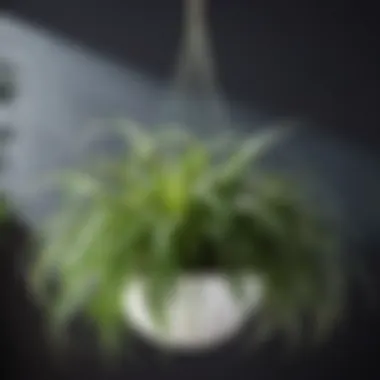Discover the Best Indoor Plants for Novice Gardeners: A Comprehensive Guide


Materials:
- High-quality potting soil: 5 lbs
- Variety of indoor plants (e.g., snake plant, pothos, spider plant): 3 small pots
- Watering can with a narrow spout: 1
- Small gardening trowel: 1
- Pebbles or small stones for drainage: 1 bag
- Pruning shears: 1
DIY Steps:
- Select a well-lit area in your home for your indoor plants.
- Fill each pot with potting soil, leaving enough room for the plant roots.
- Gently remove the plants from their nursery pots and place them into the prepared pots.
- Add pebbles or small stones at the bottom of each pot to promote drainage.
- Water the plants thoroughly, letting any excess water drain out.
- Prune any dead or yellowing leaves to encourage new growth.
Technical Aspects:
- Timing: Choose a time when you can dedicate an hour or two to the planting process.
- Tools: Use the gardening trowel to handle soil and the pruning shears for maintenance.
- Techniques: Ensure proper drainage by adding pebbles to the bottom of the pots.
DIY Project Process:
- Position the plants in your chosen area based on their light requirements.
- Water the plants weekly or as needed, ensuring the soil remains moist but not waterlogged.
- Rotate the pots occasionally to promote even growth.
- Troubleshooting Tips: If leaves start browning, adjust watering frequency or check for pests.
- Enjoy your indoor garden and the benefits of fresh air and greenery in your home!
Introduction
Indoor plants have become a staple in modern home decor, bringing nature's beauty inside and providing numerous benefits for both mental and physical well-being. This article serves as a comprehensive guide for beginners looking to explore the realm of indoor plants, offering valuable insights and practical tips to kickstart their indoor gardening journey. By understanding the importance of incorporating indoor plants into living spaces, individuals can enhance the ambiance of their homes while reaping the rewards of plant care and nurturing.
Brief Overview of Indoor Plants
Definition of Indoor Plants
Indoor plants, also known as houseplants, are species that thrive in indoor environments, requiring minimal outdoor exposure. The specific characteristic of indoor plants lies in their ability to adapt to limited light and controlled temperatures, making them ideal for interior settings. Their resilience and aesthetic appeal make them a popular choice for novice gardeners and seasoned plant enthusiasts alike. The unique feature of indoor plants is their capacity to purify the indoor air by absorbing toxins and releasing oxygen, creating a healthier living space.
Benefits of Indoor Plants
The benefits of indoor plants extend beyond their visual appeal, encompassing a range of advantages for both individuals and their surroundings. Indoor plants have been associated with improved air quality, reduced stress levels, and enhanced mood and productivity. They serve as natural humidifiers, releasing moisture into the air and promoting a more comfortable indoor climate. Additionally, indoor plants offer opportunities for creative expression through plant care and arrangement, fostering a sense of accomplishment and connection to nature.
Growing Popularity of Indoor Gardening
Rising Trend of Indoor Greenery
The rising trend of indoor greenery reflects a growing appreciation for the aesthetic and health benefits of indoor plants. As more people seek to bring nature into their homes, indoor gardening has gained popularity as a rewarding and sustainable hobby. The key characteristic of this trend is its versatility, allowing individuals to personalize their indoor spaces with a variety of plant species that suit their preferences and lifestyle. One of the advantages of the rising trend of indoor greenery is its ability to transform living areas into vibrant and tranquil sanctuaries, promoting relaxation and well-being.
Health and Wellness Impact
Indoor gardening has significant health and wellness impacts, contributing to overall well-being in various ways. The presence of indoor plants has been linked to stress reduction, improved concentration, and enhanced cognitive function. By creating indoor green oases, individuals can cultivate a connection to nature within their daily surroundings, fostering a sense of tranquility and balance. The unique feature of indoor plants in enhancing health and wellness lies in their ability to purify the air, increase oxygen levels, and reduce pollutants, creating a harmonious indoor environment conducive to physical and mental health.
Factors to Consider for Beginners


When delving into the world of indoor plants as a beginner, there are several crucial factors to consider to ensure the successful growth and well-being of your plants. Understanding these key elements will set a solid foundation for your indoor gardening journey.
Lighting Conditions
Direct Sunlight vs. Indirect Light
In the realm of indoor plants, the disparity between direct sunlight and indirect light plays a pivotal role in determining the appropriate plant species for your indoor space. Direct sunlight typically refers to light that shines directly on the plant, while indirect light is diffused or reflected sunlight that reaches the plant. The selection between these two options is imperative as not all plants can thrive under direct sunlight, and some may even get sunburned if exposed to it for prolonged periods.
Direct sunlight is ideal for plants that require high light intensity, whereas indirect light is more suitable for plants that prefer moderate to low light conditions. Understanding the distinction between direct sunlight and indirect light aids beginners in selecting plants that align with the natural light conditions of their indoor environment.
Understanding Natural Light Patterns
Comprehending the natural light patterns within your living space is essential for successful indoor gardening. Different areas of your home receive varying levels of natural light throughout the day, influencing the growth and health of your plants. Some plants flourish in bright, direct sunlight, while others thrive in shaded corners with indirect light.
By understanding the natural light patterns in your home, you can strategically place plants according to their specific light requirements. Observing and noting the intensity and duration of sunlight exposure in different locations will aid beginners in selecting the most suitable plants for each area of their indoor oasis.
Watering Needs
Frequency of Watering
The frequency of watering is a critical aspect of plant care that beginners must grasp to maintain optimal plant health. Different plant species have varying water requirements, with some needing frequent watering while others thrive in drier conditions. Overwatering can lead to root rot and other water-related issues, whereas underwatering can cause wilting and stunted growth in plants.
Understanding the water needs of your indoor plants involves considering factors such as plant type, potting soil, and environmental conditions. By adhering to a well-defined watering schedule based on individual plant demands, beginners can prevent water-related plant ailments and promote robust growth.
Signs of Overwatering or Underwatering
Identifying signs of overwatering or underwatering is essential for maintaining the health and vitality of indoor plants. Symptoms such as yellowing leaves, soggy soil, and wilting foliage indicate overwatering, signaling the need to adjust watering practices promptly. Conversely, dry, crispy leaves and parched soil signify underwatering, necessitating immediate hydration for the plant.
By closely monitoring plant appearance and soil moisture levels, beginners can effectively diagnose and remedy issues related to overwatering or underwatering, ensuring the longevity and prosperity of their indoor green companions.
Space and Placement
Matching Plant Size to Space Available
Matching plant size to the available space in your home is paramount for creating visually appealing and functional indoor plant arrangements. Before selecting plants, consider the dimensions and layout of your living area to determine suitable plant sizes that complement the existing decor and layout.
Compact spaces may benefit from smaller plants or hanging planters, while spacious rooms can accommodate larger specimens or multiple plant varieties. By harmonizing plant size with available space, beginners can curate a balanced indoor garden that enhances the aesthetic appeal and ambiance of their home.
Compatibility with Indoor Environment
Ensuring the compatibility of indoor plants with the environmental conditions of your home is essential for fostering healthy growth and longevity. Factors such as temperature, humidity levels, and air circulation influence the well-being of plants and must align with the needs of the selected species.
Plants that thrive in humid environments, for instance, may flourish in bathrooms or kitchens with higher moisture levels, while desert plants prefer drier atmospheres found in living rooms or bedrooms. By selecting plants that harmonize with the indoor environment, beginners can optimize growing conditions and promote the flourishing of their indoor greenery.


Top Picks for Beginner-Friendly Indoor Plants
In this article, we highlight the significance of selecting the right indoor plants for beginners, underscoring the importance of ease of care, adaptability to different environments, and aesthetic appeal. When embarking on an indoor gardening journey, choosing beginner-friendly plants sets the foundation for a successful and enjoyable experience. Beginner-friendly plants are characterized by their low maintenance requirements, resilience to common mistakes, and ability to thrive in varying light and humidity conditions. These plants serve as perfect companions for individuals looking to introduce greenery into their indoor spaces without feeling overwhelmed or discouraged.
Snake Plant (Sansevieria Trifasciata)
Low-Light Tolerance
Exploring the Low-Light Tolerance feature of the Snake Plant reveals its unique ability to thrive in indoor environments with minimal natural light. This characteristic makes it an ideal choice for individuals with shaded living spaces or limited access to sunlight. The Snake Plant's capacity to thrive in low-light conditions not only simplifies care routines but also ensures the plant remains healthy and vibrant even in suboptimal lighting settings.
Air-Purifying Qualities
Delving into the Air-Purifying Qualities of the Snake Plant sheds light on its remarkable ability to cleanse indoor air by removing toxins and impurities. This feature not only contributes to a healthier indoor environment but also enhances the aesthetic appeal of any living space. The Snake Plant's air-purifying qualities make it a popular choice for beginners seeking to integrate plants that offer dual benefits of visual beauty and improved indoor air quality.
Spider Plant (Chlorophytum Comosum)
Easy Propagation
The Spider Plant's Easy Propagation feature underscores its suitability for beginners looking to expand their plant collection through simple propagation methods. This characteristic enables individuals to multiply their Spider Plant effortlessly, making it an excellent choice for those interested in experimenting with plant propagation techniques. The Spider Plant's ease of propagation adds an exciting element to indoor gardening, allowing beginners to witness the plant's growth and development firsthand.
Adaptability to Different Conditions
Exploring the Adaptability to Different Conditions of the Spider Plant showcases its versatility in thriving across various indoor environments. This characteristic makes the Spider Plant a valuable addition to any beginner's indoor plant collection, as it can adapt to different light intensities, humidity levels, and care routines. The plant's adaptability ensures it remains resilient and flourishing, even amidst changing environmental conditions.
Pothos (Epipremnum Aureum)
Variegated Foliage
The Variegated Foliage of the Pothos plant introduces a visual dimension to indoor spaces, characterized by its distinct leaf patterns and colors. This unique feature adds aesthetic charm to any room, serving as a focal point within a plant collection. The Pothos plant's variegated foliage enhances the overall ambiance of indoor areas while requiring minimal maintenance, making it a preferred choice for beginners looking to elevate their indoor decor with visually appealing plants.
Forgiving of Irregular Care
The Forgiving of Irregular Care aspect of the Pothos plant highlights its resilience to occasional lapses in care routines. This quality ensures that the plant remains healthy and vibrant even when subjected to inconsistent watering schedules or fluctuations in light exposure. The Pothos plant's forgiving nature provides beginners with peace of mind, allowing them to enjoy the beauty of indoor gardening without undue stress or fear of inadvertently harming their plants.
Caring for Indoor Plants
Caring for indoor plants is a crucial aspect of maintaining a thriving indoor garden. In this article, we will delve into the essential practices and considerations that go into ensuring your indoor plants remain healthy and vibrant. By understanding how to properly care for your plants, you can create a flourishing oasis within your home, benefiting both your space's aesthetic appeal and your well-being.
Watering and Drainage
Proper Watering Techniques
Proper watering techniques play a significant role in the overall health of indoor plants. Watering plants correctly involves striking a delicate balance to provide adequate moisture without causing issues such as root rot or dehydration. By addressing the specific needs of each plant variety and considering factors like soil type and pot size, you can ensure optimal hydration for your indoor green companions. Emphasizing the importance of proper watering techniques in this article contributes to helping beginners navigate the fundamental care practices necessary for a successful indoor gardening experience.


Choosing Suitable Pots with Drainage Holes
Selecting suitable pots with drainage holes is essential for promoting healthy plant growth. Adequate drainage allows excess water to escape, preventing waterlogged soil that can lead to root suffocation and diseases. The presence of drainage holes also aids in preventing mineral buildup in the soil, ensuring a well-balanced environment for plant roots. Discussing the significance of choosing pots with drainage holes in this article highlights a vital component of indoor plant care, enabling beginners to make informed decisions when selecting containers for their green companions.
Pruning and Maintenance
Trimming Dead Leaves
Trimming dead leaves is a key practice in plant maintenance, serving both aesthetic and functional purposes. Removing decaying or yellowing leaves not only enhances the visual appeal of plants but also directs the plant's energy towards healthy growth. By regularly inspecting and pruning dead foliage, you can prevent the spread of diseases and promote overall plant vitality. Exploring the technique of trimming dead leaves in this article underscores its importance in fostering a thriving indoor garden, providing beginners with the necessary skills to maintain plant health effectively.
Encouraging Growth
Encouraging growth in indoor plants involves implementing strategies that stimulate healthy development and vigor. From providing adequate light and nutrients to employing techniques like pruning and fertilizing, nurturing growth is essential for maximizing the beauty and longevity of your plants. Highlighting the role of growth promotion in this article illuminates the methods through which beginners can actively support their plants' flourishing, instilling confidence and knowledge in cultivating a vibrant indoor garden.
Creating an Indoor Garden Oasis
In the realm of indoor gardening, the concept of creating an indoor garden oasis holds immense significance. It goes beyond simply placing plants indoors to transforming living spaces into tranquil and vibrant retreats. This section emphasizes the crucial role that indoor garden oases play in enhancing the aesthetics, air quality, and overall ambiance of homes. By focusing on plant combinations, arrangements, and decorative elements, individuals can curate personalized indoor sanctuaries that promote well-being and connection with nature.
Plant Combinations and Arrangements
Mixing Plant Varieties
Mixing plant varieties within indoor gardens is a key aspect of creating an inviting and visually appealing space. By combining different types of plants with varying shapes, sizes, textures, and colors, individuals can establish a dynamic and harmonious botanical environment. This practice not only adds aesthetic interest but also fosters biodiversity within the indoor ecosystem. Mixing plant varieties allows for creative expression and provides opportunities to cater to specific light and care requirements, ensuring a well-rounded and thriving indoor garden.
Utilizing Vertical Space
Utilizing vertical space is a strategic approach to maximizing indoor gardening potential, especially in limited areas. By incorporating hanging planters, wall-mounted holders, or vertical shelving units, individuals can optimize unused vertical spaces to display a diverse array of plants. This technique not only adds visual intrigue by transforming plain walls into green backdrops but also offers functional benefits like freeing up floor space and improving air circulation. Utilizing vertical space encourages unique plant arrangements and helps create a lush and captivating indoor garden landscape.
Incorporating Decorative Elements
Choosing Stylish Planters
The choice of stylish planters serves as a significant decorative element that elevates the overall aesthetic appeal of indoor garden spaces. Apart from serving as functional containers for plants, stylish planters contribute to the design cohesion and personality of indoor gardens. Selecting planters in varying materials, shapes, and colors allows individuals to customize their indoor oasis according to their style preferences and existing home decor. Stylish planters can act as focal points, accentuating the beauty of plants and adding a touch of sophistication to the indoor environment.
Adding Personal Touches
Adding personal touches to indoor gardens imparts a sense of individuality and care to the space. Incorporating personal touches such as decorative rocks, meaningful trinkets, or custom plant labels infuses warmth and personality into the indoor oasis. These customized elements not only reflect the personality and interests of the individual but also create a more intimate connection with the indoor garden. Personal touches add a unique charm to indoor spaces, making them more inviting and conducive to relaxation and enjoyment.
Conclusion
Embracing Indoor Gardening as a Beginner
Nurturing Green Thumb Skills
Nurturing green thumb skills plays a pivotal role in the overall progression of novice indoor gardeners. It involves honing the ability to care for plants effectively, understand their growth needs, and develop a nurturing instinct towards fostering plant health. Green thumb skills encompass the knowledge of different plant varieties, their water and light requirements, as well as the art of troubleshooting common plant issues. For beginners, cultivating green thumb skills offers a sense of accomplishment and a fulfilling hobby that aids in stress relief and mental well-being.
Enjoying the Benefits of Indoor Plants
Enjoying the benefits of indoor plants is a gratifying experience for beginners delving into indoor gardening. The advantages range from indoor air purification, mood enhancement, to a visually appealing ambiance that indoor plants provide. By incorporating plants into their living spaces, individuals can create a calming retreat from daily stresses, boost creativity and productivity, and foster a sense of accomplishment as their plant companions flourish under their care. Enjoying the benefits of indoor plants motivates beginners to continue nurturing their green friends, fostering a deeper appreciation for the beauty and tranquility plants bring into their homes.







